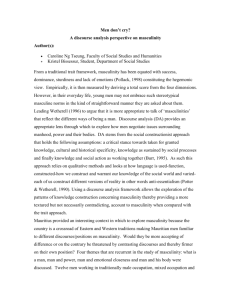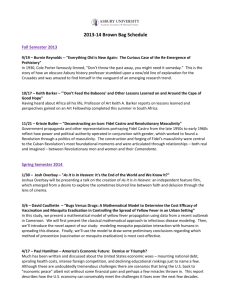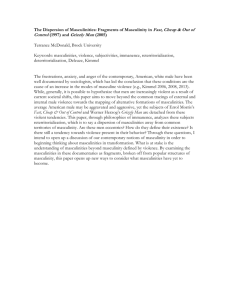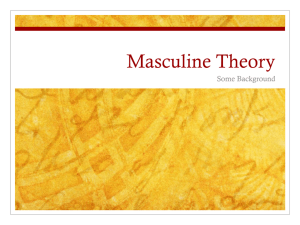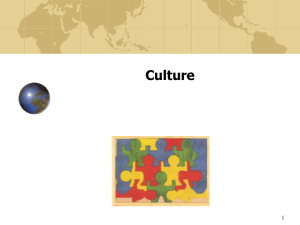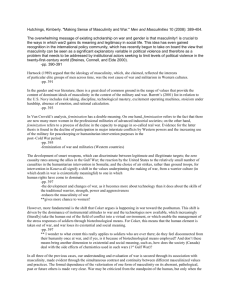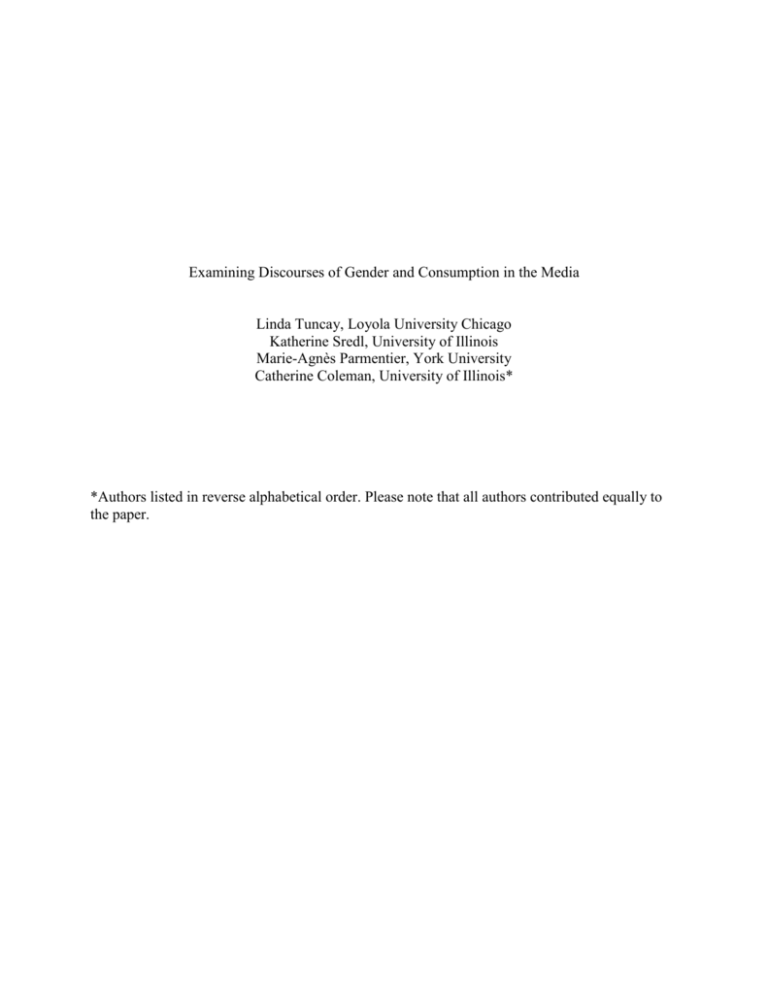
Examining Discourses of Gender and Consumption in the Media
Linda Tuncay, Loyola University Chicago
Katherine Sredl, University of Illinois
Marie-Agnès Parmentier, York University
Catherine Coleman, University of Illinois*
*Authors listed in reverse alphabetical order. Please note that all authors contributed equally to
the paper.
2
EXTENDED ABSTRACT
Gender identity is a fluid concept that has changed considerably over time, not only in its
representation in media and its interpretation by consumers, but also in its conceptualization by
researchers. Using hermeneutic analysis, a method used by prior consumer researchers, (e.g.,
Humphreys forthcoming; Coskuner 2006; Sherry 1995; Hirschman 1988), this paper explores
gender and consumption discourses in popular media. Because gender is a relational and
evolving construct, this study explores masculinity and femininity together to gain a holistic
view of gender discourses in today’s society. Specifically, the authors draw from two popular
television shows, Entourage and Sex and the City, to illustrate how contemporary notions of
femininity and masculinity are intertwined with consumption. The researchers found that the
characters in both shows struggled with tensions between more traditional gender roles and the
assumption of new, postmodern roles intimately associated with consumption (see, for example,
Firat and Venkatesh 1995 for discussion on the assumption of postmodern roles). The nuances of
these tensions are less frequently mentioned in popular media.
Three themes of masculinity emerged in Entourage that were both rooted in prior research as
well as interwoven with more feminized notions of masculinity not extensively examined in
previous inquiries. The first theme that emerged in the show was the Peter Pan ethos of
childhood play and fun (Register 2001) and the Playboy lifestyle of self-indulgence and sexual
conquests (Osgerby 2001). For the characters in Entourage, consumption is instrumental in
enacting the masculine themes of the Peter Pan and Playboy lifestyles. At the same time, it is
intertwined with traditionally feminized notions of gift giving and shopping. Second, the theme
of buddydom, or the celebration of friendships with other men, was prevalent in Entourage.
However, the characters’ enactment of this relationship was more closely associated with a nontraditional family unit than with traditional notions of male bonding. While women are most
often associated with communal goals, the portrayal of the Entourage “family” is reflective of
broader shifts in the U.S. towards “non-traditional” households, including men living together
beyond their college years (Lavigne 2004). Third, the consumption of “toys” has been
demonstrated in prior research to be an important part of the enactment of masculinity (Fiske
1987) and is a central part of the male characters’ lives in Entourage. But the quest for
acquisition sometimes causes internal struggles for the characters when it conflicts with their
desire to remain authentic. The motivation for authenticity has been demonstrated as a core
theme of masculinity for Gen X men in prior research (Tuncay 2005). This struggle was
particularly evident in the breadwinner, Vince, in a tension between his desire to take on
“meaningful” acting parts in independent films and offers to act in commercialized, yet lucrative
studio roles that would subsidize the characters’ Hollywood consumption habits. Thus, in
Entourage, several themes of masculinity emerged that resonated with prior research on gender
and consumer behavior. However, the themes of this study were intertwined with
conceptualizations of gender more traditionally associated with females, such as familial
relationships, gift giving, shopping, and emphasis on physical appearance. While in the recent
past, these behaviors have been associated with a segment of male consumers called
“metrosexuals,” such behaviors have now moved into the mainstream Thus, it is evident that new
forms of masculinity are emerging, and are represented in popular media.
Three themes of gender fluidity and consumption also emerged in Sex and the City. While
some of these themes have been discussed in prior research, the show demonstrates anxieties
about balancing traditional and changing notions of femininity and masculinity. First, tensions
3
between strict traditional gender roles and gender fluidity are prevalent. Negotiations over
gender roles are demonstrated in the character Miranda, who struggles with her non-conformity
to traditional gender roles when, for example, she prioritizes her career as a corporate lawyer,
purchases a home and is faced with housekeeping. This tension is further demonstrated in the
second theme that explores the costs of freedom and independence. Sex and the City displayed
notable violations of traditional gender roles; in particular, the narratives of Samantha Jones
portray striking examples of female sexual freedom. In asserting her independence and power
through professional accomplishment, financial independence, sex without ties and home
ownership, she is also forced to face her vulnerabilities. Third, the characters of Sex and the City
struggle with the quest for authenticity, both in their consumption and in their identities. Much
like in Entourage, the theme of authenticity builds through various storylines in which
consumption actions are developed as metaphors for broader themes of life. For example, for the
women of Sex and the City, the Playboy Mansion epitomizes notions of fantasy—sexual freedom
and an idealized and luxurious lifestyle, especially for Samantha. However, their visit to the
mansion ultimately signifies a lack of authenticity and fails to maintain the positive connotations
of fantasy.
This research demonstrates that the characters of both shows actively explore masculine and
feminine roles, though not without anxiety, as they move through new and fluid identities of
gender that often are enacted through consumption. Tensions between traditional masculinity and
alternative masculinities have been examined by past researchers (see, for example, Holt and
Thompson 2004; Otnes and McGrath 2001). But in Entourage, the characters find ways to
reestablish and reinforce their masculinities as they create new roles. In Sex and the City, several
themes of gender found in prior research also emerged. While the notion of juggling and
independence has been discussed in prior research (e.g., Thompson 1996) and despite acclaim in
the popular press about ground-breaking portrayals of contemporary women, it is evident that the
characters of Sex and the City still struggle to negotiate the gains of feminism with more
traditional feminine ideals, much like how the characters of Entourage balance traditional gender
roles with new masculine ideals. The authors find that these themes are reflective of ideological
gains and shifts exemplified in feminist agenda and that, to a greater extent, they question what
happens when these gains have been made.
4
References
Coskuner, Gokcen (2006) “Grooming Masculinities: A Poststructuralist Analysis of
Masculinity Discourses in Films,” Advances in Consumer Research, 33, 63.
Firat, A. Fuat and Allandi Venkatesh (1995), “Liberatory Postmodernism and the Reenchantment
of Consumption”, Journal of Consumer Research, 22 (3), 239-267.
Hirschman, Elizabeth C. (1988) "The Ideology of Consumption: A Structural-Syntactical
Analysis of 'Dallas' and 'Dynasty'," Journal of Consumer Research, 15 (3), 344-359.
Holt, Douglas and Craig Thompson (2004), “Man-of-action heroes: The pursuit of heroic
masculinity in everyday consumption,” Journal of Consumer Research, 31(2), 425-440.
Humphreys, Ashlee (Forthcoming), “Stacking the Deck: Gambling in Film and the
Legitimization of Casino Gambling”, Explorations in Consumer Culture Theory, Eds. Eileen
Fischer and John Sherry, Routledge Press.
Lavigne, Paul (2004), “Roommates: It's a guy thing,” Dallas Morning News, Accessed January
5, 2008, at www.baylor.edu/pr/bitn/news.php?action=story&story=34968
Osgerby, Bill (2001), Playboys in Paradise, New York, NY: Oxford International
Publishers.
Otnes, Cele C. and Mary Ann McGrath (2001), “Perceptions and realities of male shopping
behavior,” Journal of Retailing, 77, 111-37.
Register, Woody (2001), “Everyday Peter Pans: Work, Manhood, and Consumption in
Urban America, 1900-1930,” in Boys and Their Toys, ed. Roger Horowitz, New York, NY:
Routledge, 199-228.
Sherry, John F. (1995), "Bottomless Cup, Plug in Drug: A Telethnography of Coffee," Visual
Anthropology, v.7 (4), 355-74.
Thompson, Craig J. (1996) “Caring Consumers: Gendered Consumption Meanings and the
Juggling Lifestyle,” Journal of Consumer Research, 22 (4), 388-408.
Tuncay, Linda (2005), "Men's Responses to Depictions of Ideal Masculinity in Advertising,"
Advances in Consumer Research, 2006, 33, 63.

